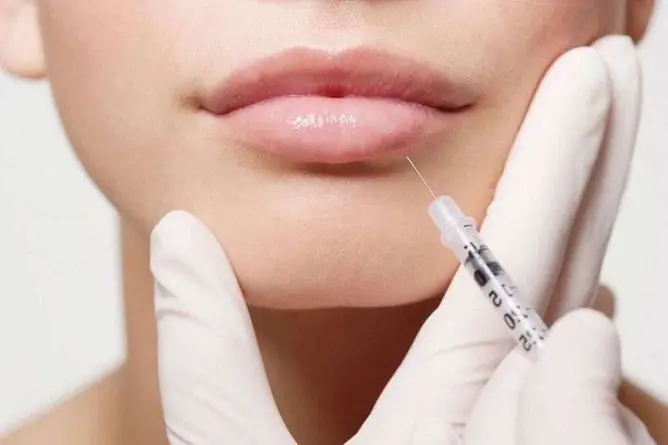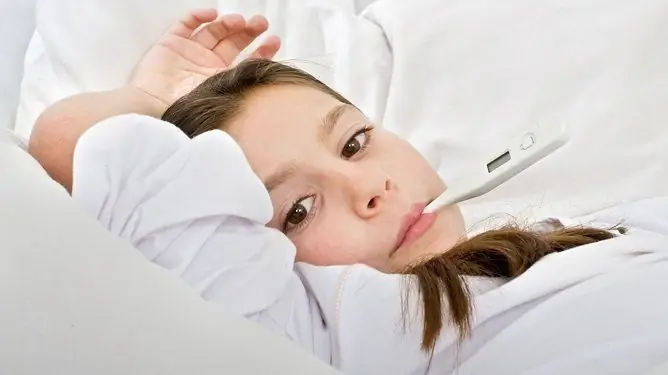- Author Rachel Wainwright [email protected].
- Public 2023-12-15 07:39.
- Last modified 2025-11-02 20:14.
Temperature for chickenpox in children
The content of the article:
-
Chickenpox fever
- How long does the temperature last with chickenpox in a child
- What numbers does it rise to?
- Rashes and other symptoms of chickenpox
-
Chickenpox: A Brief Introduction to Infection
- How to treat chickenpox
- Medication
- Physical methods of cooling
- General recommendations
- Is the disease dangerous
- Is it possible to prevent the development of chickenpox
- Video
Chickenpox (chickenpox) is an acute viral disease that occurs mainly in childhood. An increase in temperature with chickenpox in children always occurs, this is one of the main symptoms. The febrile period can last from 1-3 days to a week or more. It depends on the intensity of the rash and the presence of complications of the disease. You can also bring down the temperature at home using physical methods of cooling and medications.

Fever is one of the main symptoms accompanying chickenpox
Chickenpox fever
Chickenpox is an infectious disease, so its main symptom is an increase in body temperature. Parents need to pay attention to how high the temperature rises, as well as how long and how the febrile period lasts.
How long does the temperature last with chickenpox in a child
A high temperature with chickenpox persists throughout the entire period of the rash. Thus, the duration of the fever depends on the duration of the rash. With a mild course of the disease, fever can persist for only 2-3 days, with a severe course - from 7-10 days or more.
What numbers does it rise to?
The most common fever (temperature rise to 38.5-39 ° C), much less often - subfebrile condition (about 37 ° C).
In this case, a wavy course of fever is characteristic:
- appears when the rash spreads over the body;
- the temperature returns to normal if new rashes do not appear.
During the entire period of the illness, the temperature can rise and fall several times - this is a normal reaction of the body.
Rashes and other symptoms of chickenpox
The main symptom of chickenpox is a generalized skin rash. Rashes appear simultaneously with an increase in body temperature, rashes from 2-5 days to 10 days or more. A rash with chickenpox goes through several stages of development - a spot, a papule, a vesicle, a crust.
| Rash element | Appearance, how long it lasts |
| Spot | At the beginning of the disease, a pink spot appears, which is 3-4 mm in diameter. The spot does not rise above the level of the skin, but eventually turns into a papule. |
| Papule | A papule (nodule) is the next element after the spot in the development of a rash with chickenpox. Papule dense to the touch, rises above the skin. |
| Vesicle |
The papule turns into a vesicle - a bubble filled with fluid. The vesicle has one chamber, the contents are transparent inside. Often the vesicles are surrounded by a zone of hyperemia. After 1-2 days, the bubbles break open. |
| Crust | After opening the bubbles, a brown crust appears on the skin. It lasts for several days. |
The rash is accompanied by severe itching. The rashes appear in waves, and each element of the rash goes through its own development cycle, so spots, papules, vesicles and crusts can be seen on the skin at the same time.
In most cases, a chickenpox rash after recovery disappears without a trace, since the rash does not affect the growth layer of the epidermis. If you comb them, after the disappearance of the rash, a scar remains on the skin.
In children, the disease is easier than in adults. Additional symptoms depend on the severity of the disease:
- With a mild form, the general condition is not disturbed, other symptoms (except for fever and rash) do not appear. The child's appetite remains normal, the child is conscious and active.
- Violation of general well-being indicates a more severe form of the disease. The baby becomes lethargic, refuses to eat, sleeps most of the day.
Chickenpox: A Brief Introduction to Infection
Chickenpox is an acute infectious disease that is transmitted by airborne droplets. The cause of the disease is one of the herpes viruses (herpesvirus of the third type, varicella-zoster).
Most often, the disease develops in children aged 1 to 7 years, but anyone can get sick (both a child and an adult). Chickenpox is a highly contagious disease, that is, it is very easy to get infected. The virus is transmitted by airborne droplets, it is enough to be in the same room with the source of infection. A person begins to spread viruses a few days before the appearance of the rash, and ceases to be infectious after the last element of the rash dries up.
How to treat chickenpox
Etiotropic (aimed at eliminating the cause) treatment of chickenpox is rarely used, only in severe disease. In most cases, symptomatic treatment is sufficient - fighting fever and other symptoms of the disease. To do this, you can use medications, physical methods of cooling, and general recommendations.
Medication
The main method of fighting fever is the use of antipyretic drugs. Not all medications can be given to children. It is not recommended to use almost all anti-inflammatory drugs, especially Analgin and Acetylsalicylic acid, as this can cause the development of dangerous complications (Reye's syndrome, bone marrow damage).
What antipyretic drugs can be given to children with chickenpox:
| Active substance | Other names | How to use |
| Ibuprofen | Nurofen (tablets, syrup, rectal suppositories) | The maximum single dose is 10 mg per 1 kg of body weight, the interval between doses should be at least 6 hours. |
| Paracetamol | Panadol (tablets, oral suspension) | Take 10-15 mg per 1 kg of body weight when the body temperature rises above 38.5 ° C (no more than once every 4 hours). |
For severe itching, antihistamines can be used. It is not necessary to use local antiseptics (brilliant green, etc.) for chickenpox. The use of such drugs does not speed up recovery.

Nurofen is an antipyretic that can be used in children
Physical methods of cooling
Physical cooling methods can be used to lower the temperature of chickenpox. It is recommended to treat the skin with cool water, apply an ice pack to the projection sites of large vessels (groin, armpits, elbow and knee fossa). It is necessary to resort to physical cooling only in those cases when the body temperature rises above 38.5 ° C.
General recommendations
In the acute period of the disease, especially in violation of the general well-being of the child, it is recommended to observe bed rest. It is extremely important to drink enough water - 50 ml per 1 kg of body weight. You can give clean water, green and black tea, milk with honey, fruit drinks and juices.
The following tips will help alleviate the course of the disease:
- Bathing your baby in a cool (not cold) water bath can help relieve itching and lower body temperature.
- Cut your nails short to prevent your child from scratching the skin.
- Regularly ventilate the room in which the baby is located.
- Do not wrap the child.
You can go outside and visit public places 5 days after the last element of the rash has appeared. Until this time, the child continues to secrete viruses and is dangerous to the people around him.
Is the disease dangerous
In childhood, chickenpox in most cases proceeds without consequences.
Children with weakened immunity may develop severe forms of chickenpox - hemorrhagic, bullous and gangrenous. In this case, the disease can be fatal. Severe complications of chickenpox include encephalitis (inflammation of the brain), myocarditis, purulent skin lesions.
Is it possible to prevent the development of chickenpox
It is believed that it is better to get sick with chickenpox in childhood, since in adults the disease is much more severe. In fact, it is better not to get sick with chickenpox at all, since any weakening of the immune function can cause a relapse in the form of herpes zoster. Vaccination will help prevent the development of chickenpox, which creates immunity from the disease for many years. There are two chickenpox vaccines on the market - Okavax and Varilrix, but they are not included in the national vaccination schedule.
Video
We offer for viewing a video on the topic of the article.

Anna Kozlova Medical journalist About the author
Education: Rostov State Medical University, specialty "General Medicine".
Found a mistake in the text? Select it and press Ctrl + Enter.






